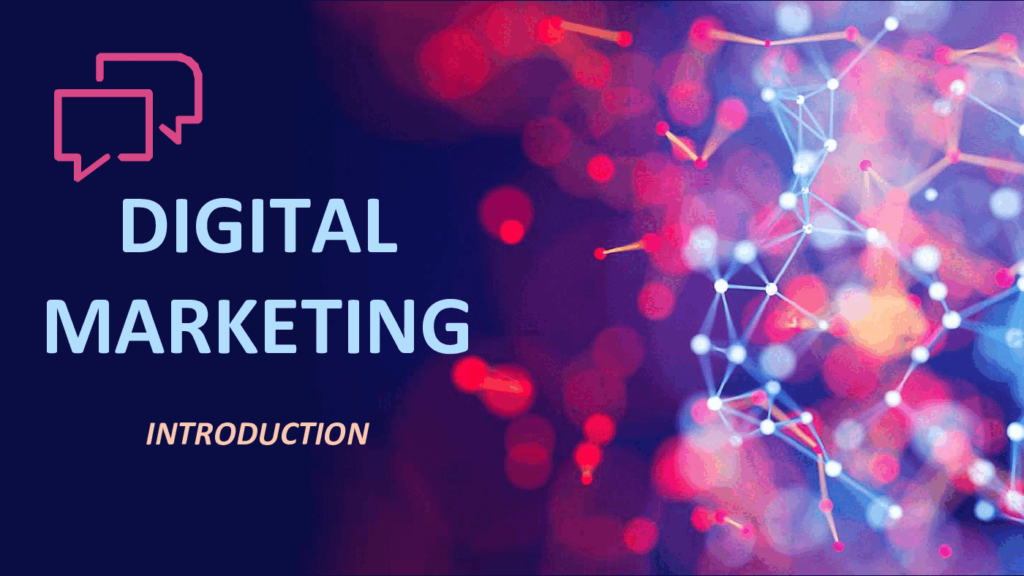#01-Module 1: Introduction to Marketing

Before delving into digital marketing, it's essential to grasp the foundational concepts such as the nature of a market, the multifaceted aspects of marketing, and the evolution into digital marketing.
Market
A market refers to the environment or system where buyers and sellers interact to facilitate the exchange of goods, services, or information. It is a mechanism that brings together individuals or entities with products or services to offer and those who are seeking to acquire them. Markets can take various forms, and they exist at different levels, from local and regional markets to global markets. Here are some key aspects of a market:
1. Exchange of Goods and Services: Markets provide a platform for the buying and selling of products or services. This exchange can involve physical goods, such as consumer products or raw materials, as well as services like consulting, healthcare, or education.
2. Buyers and Sellers: Participants in a market include buyers (consumers or businesses seeking goods or services) and sellers (individuals or organizations offering products or services). The interaction between buyers and sellers creates the dynamics of supply and demand.
3. Price Determination: Prices are often determined by the forces of supply and demand within a market. When demand for a product or service is high and supply is limited, prices tend to rise, and vice versa.
4. Competition: Markets are characterized by competition among sellers who vie for the attention and patronage of buyers. Competition can lead to innovations, improved quality, and better prices for consumers.
5. Market Structure: Markets can have different structures, such as perfect competition, monopoly, oligopoly, or monopolistic competition, depending on the number of sellers and their control over prices.
6. Marketing Channels: The pathways through which products or services move from producers to consumers are known as marketing channels. These channels can involve intermediaries like wholesalers, retailers, and distributors.
7. Geographic Scope: Markets can be local, national, or global, depending on the reach of the transactions and the geographical boundaries involved.
8. Market Segmentation: In marketing, businesses often analyze and segment markets based on various criteria, such as demographics, psychographics, behavior, or geographic location. This helps tailor products and marketing strategies to specific target audiences.
Markets play a fundamental role in economic systems, serving as the foundation for trade and commerce. They are dynamic and subject to fluctuations based on changes in consumer preferences, economic conditions, technological advancements, and other factors. Understanding the dynamics of a market is crucial for businesses to make informed decisions regarding product development, pricing, promotion, and distribution.






Marketing
Marketing is a multifaceted business discipline that involves a set of activities, strategies, and processes designed to create, communicate, deliver, and exchange value with customers, clients, partners, and society at large. The primary goal of marketing is to meet the needs and wants of target audiences while achieving the objectives of the organization. It goes beyond just selling products or services; it encompasses a comprehensive approach to understanding customers, creating offerings, and building lasting relationships.
Key Components of Marketing:
1. Understanding Customer Needs: Successful marketing starts with a deep understanding of the target audience. This involves market research to identify consumer needs, preferences, and behaviors.
2. Product Development: Creating products or services that fulfill identified needs and differentiating them from competitors in the market.
3. Promotion: Communicating the value of products or services to the target audience through various promotional channels such as advertising, public relations, and digital marketing.
4. Distribution: Planning and executing the efficient movement of products or services from the producer to the consumer. This involves considerations like logistics, supply chain management, and retail strategies.
5. Pricing: Determining the optimal pricing strategy based on factors like production costs, competitor pricing, and perceived value to the customer.
6. Market Segmentation: Dividing the overall market into smaller, more manageable segments based on demographic, psychographic, geographic, or behavioral characteristics.
7. Branding: Building a distinctive brand identity that sets a product or company apart from competitors and creates recognition and loyalty.
8. Customer Relationship Management (CRM): Focusing on creating and maintaining strong relationships with customers to enhance satisfaction, loyalty, and repeat business.
9. Market Research: Continuously gathering and analyzing data to stay informed about market trends, consumer preferences, and competitors.
10. Ethical Considerations: Ensuring that marketing activities adhere to ethical standards and legal regulations, promoting honesty and transparency in communication.
Marketing is a dynamic field that continually evolves with changes in consumer behavior, technology, and global markets. It plays a pivotal role in the success of businesses by connecting products or services with the right audience and creating value for both customers and the organization.




Digital Marketing:
Digital marketing refers to the use of digital channels, platforms, and technologies to promote products, services, or brands to a targeted audience. Unlike traditional marketing methods that rely on offline channels such as print or television, digital marketing leverages online mediums to reach and engage with potential customers. It encompasses a wide range of strategies and tactics, providing businesses with effective tools to connect with their audience in the digital space.
Digital Marketing platforms.
Digital marketing operates on various platforms, each serving a specific purpose and catering to different aspects of online promotion. Here are some key platforms commonly used in digital marketing:
1. Search Engines:
– Google: Google is the most widely used search engine, and SEO (Search Engine Optimization) strategies are employed to enhance a website’s visibility in Google’s search results.
– Google, Bing, Yahoo: Other search engines that are used, albeit to a lesser extent, for SEO and PPC campaigns.
2. Social Media:
– Facebook: Popular for targeted advertising, brand promotion, and community building.
– Instagram: Known for visual content, influencer marketing, and engagement.
– Twitter: Used for real-time updates, customer interaction, and brand awareness.
– LinkedIn: Mainly for B2B marketing, professional networking, and industry-related content.
– Pinterest: Ideal for businesses with visually appealing products or services.
3. Content Marketing:
– Blogs: Self-hosted or on platforms like WordPress, Medium, or Blogger for publishing informative and engaging content.
-Video Platforms: YouTube is a major platform for video content.
4. Email Marketing:
– Email Service Providers (ESPs):Platforms like Mailchimp, Constant Contact, for managing and sending email campaigns.
5. Pay-Per-Click (PPC) Advertising:
– Google Ads: For running text and display ads on Google’s search and display network.
– Social Media Advertising Platforms: Facebook Ads, Instagram Ads, Twitter Ads, LinkedIn Ads, etc., for paid social media promotion.
6. Affiliate Marketing:
– Affiliate Networks: Platforms like Amazon Associates, and Affiliate facilitate partnerships between advertisers and affiliates.
7. Analytics and Data:
– Google Analytics: A powerful tool for tracking website and user data.
– Social Media Insights: Analytics provided by each social media platform for assessing campaign performance.
8. Customer Relationship Management (CRM):
-Salesforce, HubSpot, and others: CRM platforms that help manage customer relationships, track interactions, and personalize marketing efforts.
9. Online Public Relations (PR):
– Press Release Distribution Services: PR Newswire, Business Wire, and others for disseminating press releases.
– Social Media Platforms: Monitoring and engagement on platforms like Twitter, LinkedIn, and Facebook.
10. E-commerce Platforms:
– Shopify, WooCommerce, Magento: Platforms for businesses involved in online selling and e-commerce.
11. Influencer Marketing Platforms:
– Platforms that connect businesses with influencers for marketing collaborations.
Each platform serves a specific function, and an effective digital marketing strategy often involves a combination of these platforms tailored to the target audience and business goals. Successful digital marketers choose platforms based on where their target audience is most active and engaged.
Key Components of Digital Marketing:
1. Search Engine Optimization (SEO):
– Optimizing online content to improve its visibility on search engine results pages (SERPs), making it more likely to be found by users searching for relevant information.
2. Content Marketing:
– Creating and distributing valuable and relevant content to attract and retain a clearly defined audience. Content can include blog posts, articles, videos, infographics, and more.
3. Social Media Marketing:
– Utilizing social media platforms (e.g., Facebook, Instagram, Twitter, LinkedIn) to connect with the target audience, build brand awareness, and promote products or services.
4. Email Marketing:
– Sending targeted messages and promotions directly to a user’s email inbox, often used for customer retention, nurturing leads, and promoting special offers.
5. Pay-Per-Click (PPC)
Advertising:
– Placing online ads and paying a fee each time a user clicks on the ad. Common PPC platforms include Google Ads and social media advertising.
6. Affiliate Marketing:
– Partnering with other businesses or individuals (affiliates) to promote products or services and earning a commission for each sale generated through the affiliate’s marketing efforts
7. Analytics and Data-Driven Marketing:
– Using data and analytics tools to measure the performance of digital marketing campaigns, understand user behavior, and make informed decisions for future strategies.
Digital marketing offers several advantages, including the ability to target specific demographics, track and analyze campaign performance in real-time, and reach a global audience. It has become an essential component of modern marketing strategies due to the increasing prevalence of digital technologies and the shift in consumer behavior toward online platforms.